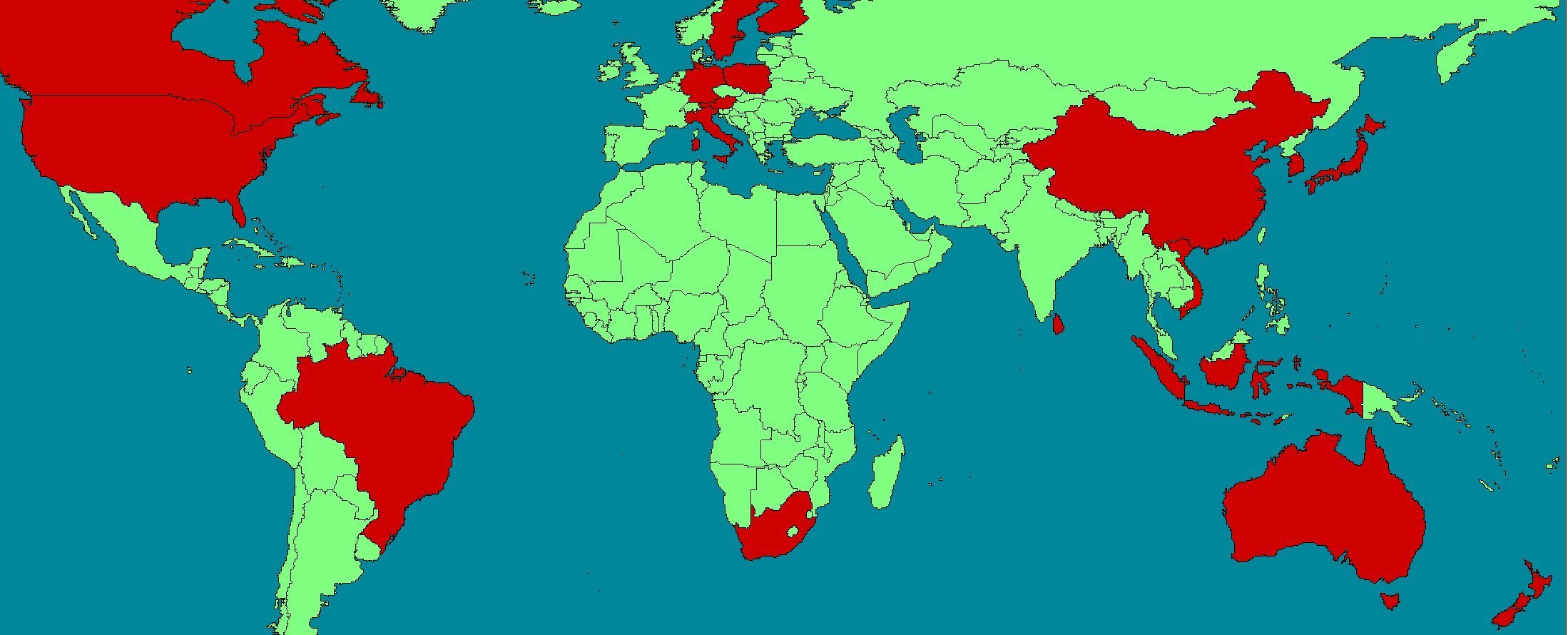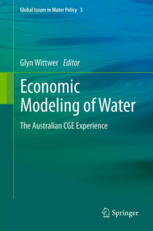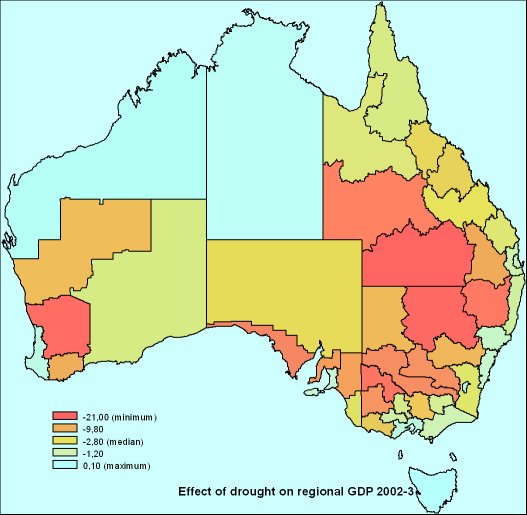
Countries shaded red are modelled by variants of the TERM model
The TERM multi-regional CGE model
TERM developments
Documentation of TERM
Complete list of TERM-related publications
TERM Training courses
TERM for other countries
Download Australian TERM model and data
TERM in the cloud

Countries shaded red are modelled by variants of the TERM model
TERM (The Enormous Regional Model) is a "bottom-up" CGE model which treats each region as a separate economy. The key feature of TERM, in comparison to predecessors such as MMRF, is its ability to handle a greater number of regions or sectors. The first TERM master database distinguished 144 sectors and 57 regions (nearly corresponding to the Australian Statistical Divisions). More recently, TERM has been extended to represent 216 sectors in 334 statistical areas (SA3): this allows us to split major cities into regions, and represent water catchment and tourism regions. The high degree of regional detail makes TERM a useful tool for examining the regional impacts of shocks (especially supply-side shocks) that may be region-specific. Finally, TERM has a particularly detailed treatment of transport costs and is naturally suited to simulating the effects of improving particular road or rail links.
Even though TERM is computationally efficient, it would be slow to solve if a full 216-sector, 334-region database were used. In practice, we must aggregate sectors or regions so that [the number of sectors] plus [the number of regions] does not exceed 100. The TERM database programs facilitate this aggregation. The choice of sectors or regions to aggregate is application-specific. For example, we could design aggregated regions which followed the boundaries of climatic zones or watersheds, or which highlighted the distinction between metropolitan and rural regions. Similarly the sectoral aggregation would be tailored to a particular simulation.
TERM includes a "top-down" disaggregation of employment and income within each region to smaller regions (SA2s). That is, results originally generated for the 334 SA3s may be broken down according to Australia's 2000+ SA2s. Although we have reservations about the realism of results at SLA level, we anticipate that the facility may prove useful when used with care. For example, it would enable us to say how residents of Sydney's western suburbs (a group of SLAs) fared relative to other Sydneysiders. See COPS archive item TPMH0074 for an example of this approach.
Subsequently, the SA2 data gathered from census data became the foundation for the SA3 region representation mentioned above. In practice, we could prepare a full bottom-up database for any combination of the 2000+ SA2 regions in the census. However, the SA3 representation for most practical purposes has been a sufficient representation of small regions.
Glyn Wittwer has developed a special version of TERM, TERM-H2O, to analyse the economic impacts of water shortage and of water trading. Simulations are described in a series of working papers G-186, G-222, G-228 and G-232, and in a book mentioned below.
Related journal publications include:
Previously a group at the Australian Productivity Commission used a version of TERM to see if water trading could alleviate drought. This was published as Peterson, Dwyer, Appels & Fry(2005), Water Trade in the Southern Murray-Darling Basin, The Economic Record 81. An earlier version of the paper is here.
The original version of TERM is a comparative static model. It shows, for a single year, the differences produced in the regional economies by changes in taxes, techonology, tariffs and other exogenous variables. Glyn Wittwer has recently developed a multiperiod version of TERM for Australia. This incorporates dynamic features similar to the MONASH model:
For an application of dynamic TERM, see: Dynamic general equilibrium analysis of improved weed management in Australia's winter cropping systems, by Glyn Wittwer, David T. Vere, Randall E. Jones, Garry R. Griffith, The Australian Journal of Agricultural and Resource Economics, December 2005 - Vol. 49, Issue 4, pp 363-377, Blackwell.
Other dynamic versions of TERM exist for Indonesia, Brazil, Finland, .New Zealand and USA.
Enquiries about consultancies using the Australian or Chinese versions of TERM should be addressed to Dr. Glyn Wittwer. He has used dynamic TERM for projects with various state and Commonwealth government departments. To apply TERM to other countries, contact Mark Horridge.
Using theory and data prepared by Janine Dixon for a national model, a version of dynamic TERM now includes a labour market module which links industries, occupations, skills and regions.
TERM training courses are held periodically: upcoming courses are advertised here. Past courses have been presented in South Africa 2011, Warsaw 2011, Sydney 2012, Warsaw 2013, Bandung 2014 and Beijing 2017. Typical course programs are here and here.
See COPS archive item TPMH0057 for a technical description of the model and database. An earlier version of the same paper is working paper no. G-141. Other applications are described in COPS archive items TPGW0050 and TPGW0076. An example of the standard or "reference" version of comparative static TERM as at December 2012 may be found in COPS archive item TPMH0117. Some published articles on the Australian version of TERM are:
 Book published in 2012 by Springer: "Economic Modeling of Water: The
Australian CGE Experience", Edited by Glyn Wittwer.
Book published in 2012 by Springer: "Economic Modeling of Water: The
Australian CGE Experience", Edited by Glyn Wittwer.
 Book
published in 2017 by Springer: "Multi-regional Dynamic General Equilibrium Modeling of the U.S. Economy: USAGE-TERM Development and
Applications ", Edited by Glyn Wittwer.
Book
published in 2017 by Springer: "Multi-regional Dynamic General Equilibrium Modeling of the U.S. Economy: USAGE-TERM Development and
Applications ", Edited by Glyn Wittwer.
A more complete list of TERM publications appears in this document.
You can also see lists of publications about the Chinese and Brazilian versions of TERM.
A complete worked example of TERM database production can be found here.
See a comparison of CoPS regional CGE models here.

Some results from the Australian version of TERM
Versions of TERM have been prepared for Austria, Brazil, Canada, China, Finland, Germany, India, Indonesia, Italy, Japan, Korea, New Zealand, Poland, South Africa, Sri Lanka, Sweden, USA and Vietnam.
The Chinese version is described on this page.
An example of the Polish version may be found in COPS archive item TPMH0117.
The Indonesian IndoTERM is used in these publications:
An older version of IndoTERM may be downloaded from COPS archive item TPMH0118.
An earlier Indonesian version, named EMERALD, is described in COPS archive item TPDP0038. See also TPGW0076, or Google for "Pambudi Alfian CGE Emerald". Two articles based on EMERALD are:
Some Brazilian TERM results are presented in COPS archive items TPJB0095 and PPJB0078. See also Brazil. Or, Google for "Joaquim Bento CGE TERM"
An application of the US model, USAGE-TERM is described here.
You can download and run a miniature version of the original Australian TERM yourself if you have source code GEMPACK. Download this ZIP file and study the README.TXT it contains.
You can run TERM (using Canadian data) via a web interface here.